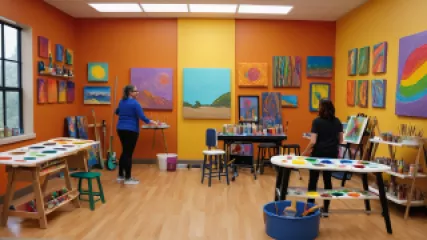Why Creative Healing Techniques Are Essential in Modern Therapy
In an increasingly fast-paced and digital world, the pressures on mental health have never been greater. Traditional talk therapy has its merits, but there's a growing recognition that creative healing techniques bring something profoundly transformative to the table. The integration of expressive arts therapy, along with other creative methods, is carving out a significant niche in modern therapy practices.
The Power of Expressive Arts Therapy
Expressive arts therapy is not just about drawing or painting; it encompasses a wide range of artistic activities including music, dance, drama, and writing. These therapies allow individuals to communicate emotions and experiences they might struggle to express verbally. For some, words are limiting; for others, they can be a barrier. Expressive arts therapy breaks down these barriers by providing alternative avenues for self-expression.
"Art can permeate the very deepest part of us, where no words exist." Eileen Miller
Studies have shown that engaging in creative activities can reduce stress, improve mood, and even enhance cognitive function. But beyond the scientific backing, the real magic lies in the personal transformations. People often discover facets of themselves they never knew existed, unlocking new ways to understand and cope with their emotions.
Creative Healing Techniques: More Than Just Art
While expressive arts therapy is a significant component of creative healing, it's not the only form. Other creative healing techniques include:
- Storytelling and Narrative Therapy
- Play Therapy
- Sandplay Therapy
- Music Therapy
- Dance/Movement Therapy
Each of these methods offers a unique approach to healing, enabling therapists to tailor their strategies to the specific needs of their clients. For example, narrative therapy helps individuals reframe their stories in empowering ways, while sandplay therapy allows them to explore their inner worlds through tactile, symbolic expression.
Digital Therapy Resources and Virtual Sessions
In the wake of the global pandemic, there has been a significant shift towards digital therapy resources and virtual therapy sessions. This shift has made therapy more accessible than ever before, allowing individuals from all walks of life to seek help from the comfort of their homes.
Virtual therapy sessions have also opened up new possibilities for integrating creative healing techniques. Therapists are now using digital platforms to conduct art therapy sessions, guiding clients through creative exercises via video calls. Digital tools such as drawing apps and virtual whiteboards are being utilized to facilitate these sessions, making it possible to engage in expressive arts therapy even at a distance.
The Rise of Mental Health Workshops
Another notable trend is the rise of mental health workshops. These workshops often incorporate creative healing techniques, providing participants with hands-on experiences that can be deeply therapeutic. Workshops can range from single-day events to week-long retreats, offering a variety of activities such as group art projects, guided meditations, and collaborative storytelling sessions.
By participating in these workshops, individuals not only gain access to valuable therapeutic tools but also build a sense of community. Sharing creative experiences with others can foster connections and support networks that are essential for long-term mental health.
Why Creativity Matters in Therapy
So, why do I believe that creative healing techniques are essential in modern therapy? The answer lies in the multifaceted benefits these techniques offer. Creativity engages the whole person—mind, body, and spirit. It taps into the subconscious, bringing to light emotions and thoughts that might otherwise remain hidden.
Moreover, creative activities can be incredibly empowering. They allow individuals to take control of their narratives, to express themselves authentically, and to heal in ways that feel natural and intuitive. By incorporating creative healing techniques into therapy, we provide people with more tools to navigate their mental health journeys.
"Creativity is intelligence having fun." Albert Einstein
This quote beautifully encapsulates the essence of creative healing. It's not just about solving problems; it's about exploring possibilities, embracing change, and finding joy in the process of self-discovery.
Personal Experiences with Creative Healing
To illustrate the impact of creative healing techniques, I'd like to share a few personal anecdotes. These stories come from individuals who have found solace and transformation through creative therapies.
Victor Garcia: Finding His Voice Through Music
Victor Garcia had struggled with depression for years. Traditional therapy had helped to some extent, but he felt something was missing. When his therapist suggested music therapy, Victor was skeptical. However, as soon as he picked up a guitar and started strumming, he felt a shift. The music allowed him to express emotions he couldn't put into words, and over time, it became a vital part of his healing journey.
Victor's story is a testament to the power of music therapy. By engaging in musical activities, he was able to connect with his emotions on a deeper level, finding a sense of release and relief that traditional therapy alone couldn't provide.
Danna Sandoval: Healing Through Dance
Danna Sandoval had always loved to dance, but she never thought it could be a form of therapy. After experiencing trauma, she found it difficult to open up in traditional therapy sessions. Her therapist introduced her to dance/movement therapy, and it changed everything. Through dance, Danna was able to express her pain and reclaim her body. The movement became a language of its own, allowing her to process her trauma in a safe and supportive environment.
Danna's experience highlights the transformative potential of dance/movement therapy. It shows how creative healing techniques can provide alternative pathways to recovery, especially for those who find it challenging to express themselves verbally.
The Future of Creative Healing Techniques
As we look to the future, it's clear that creative healing techniques will continue to play a crucial role in modern therapy. The integration of digital therapy resources and virtual therapy sessions will further expand access to these techniques, making them available to a wider audience. Additionally, ongoing research and innovation will continue to uncover new ways to harness the power of creativity for mental health.
Embracing a Holistic Approach
The future of therapy lies in a holistic approach that recognizes the interconnectedness of mind, body, and spirit. By incorporating creative healing techniques, therapists can address the whole person, fostering healing on multiple levels. This approach not only enhances the effectiveness of therapy but also empowers individuals to take an active role in their healing journeys.
The rise of mental health workshops and other community-based initiatives will also play a significant role in the future of creative healing. These programs provide opportunities for individuals to engage in creative activities in a supportive and collaborative environment, building connections and resilience along the way.
Conclusion: The Essential Role of Creativity in Therapy
In conclusion, creative healing techniques are essential in modern therapy because they offer unique and powerful ways to address mental health. By engaging in expressive arts therapy and other creative methods, individuals can access deeper levels of self-awareness, expression, and healing. The integration of digital therapy resources and virtual therapy sessions has further expanded the reach of these techniques, making them more accessible than ever before.
As we move forward, it's crucial to continue exploring and embracing creative healing techniques. They provide valuable tools for therapists and clients alike, enriching the therapeutic process and fostering lasting transformation. Whether through music, dance, art, or storytelling, creativity has the power to heal, inspire, and connect us all.
The journey of healing is deeply personal, and by incorporating creative techniques, we honor the uniqueness of each individual's path. In a world that often feels chaotic and overwhelming, creativity offers a beacon of hope, reminding us that healing is not only possible but also a beautiful and transformative journey.






